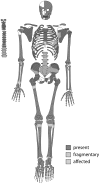On the antiquity of cancer: evidence for metastatic carcinoma in a young man from ancient Nubia (c. 1200 BC)
- PMID: 24637948
- PMCID: PMC3956457
- DOI: 10.1371/journal.pone.0090924
On the antiquity of cancer: evidence for metastatic carcinoma in a young man from ancient Nubia (c. 1200 BC)
Abstract
Cancer, one of the world's leading causes of death today, remains almost absent relative to other pathological conditions, in the archaeological record, giving rise to the conclusion that the disease is mainly a product of modern living and increased longevity. This paper presents a male, young-adult individual from the archaeological site of Amara West in northern Sudan (c. 1200 BC) displaying multiple, mainly osteolytic, lesions on the vertebrae, ribs, sternum, clavicles, scapulae, pelvis, and humeral and femoral heads. Following radiographic, microscopic and scanning electron microscopic (SEM) imaging of the lesions, and a consideration of differential diagnoses, a diagnosis of metastatic carcinoma secondary to an unknown soft tissue cancer is suggested. This represents the earliest complete example in the world of a human who suffered metastatic cancer to date. The study further draws its strength from modern analytical techniques applied to differential diagnoses and the fact that it is firmly rooted within a well-documented archaeological and historical context, thus providing new insights into the history and antiquity of the disease as well as its underlying causes and progression.
Conflict of interest statement
Figures














References
-
- Boyle P, Levin P, editors (2008) World Cancer Report 2008. Lyon: International Agency for Research on Cancer.
-
- WHO (2013) Fact sheet N°297: Cancer.
-
- David AR, Zimmerman MR (2010) Cancer: an old disease, a new disease or something in between? Nature Reviews: Cancer 10: 728–733. - PubMed
-
- Karpozilos A, Pavlidis N (2004) The treatment of cancer in Greek antiquity. European Journal of Cancer 40: 2033–2040. - PubMed
Publication types
MeSH terms
LinkOut - more resources
Full Text Sources
Other Literature Sources

